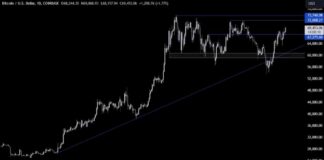USD/JPY Price Analysis and Predictions for the Week
Last week, the USD/JPY pair saw a decline to 143.43 but managed to recover significantly. As we head into the new week, the initial bias remains neutral. However, if we see a break above the 146.47 resistance level, it could suggest that the pullback from 149.35 has come to an end, and the rebound from 141.67 is likely to resume. In this scenario, the intraday bias will shift to the upside, with the potential to target 149.35 first, and then possibly reach the 100% projection level of 151.11 from 143.43. On the downside, a break below 143.43 would indicate a target of 141.67 low instead.
In the broader picture, the fall from the medium-term top of 161.94 is viewed as a correction of the overall uptrend from the 2021 low of 102.58. There is a possibility of a deeper decline towards the 38.2% retracement level of 139.26, which is in close proximity to the 140.25 support level. The risk remains tilted to the downside as long as the 55-week Exponential Moving Average (EMA) holds at 149.47. However, a decisive break above the 55-week EMA could indicate that the range for a medium-term corrective pattern has been established.
Looking at the long-term perspective, it may be premature to conclude that the uptrend from the 2011 low of 75.56 has concluded. Nonetheless, signs point towards a medium-term corrective phase beginning, with the potential for a substantial correction towards the 55-month EMA currently at 132.73.
Factors influencing USD/JPY Price Movements
Several factors can influence the price movements of the USD/JPY pair. One significant factor is the monetary policy decisions of the Federal Reserve (Fed) and the Bank of Japan (BoJ). Any changes in interest rates or quantitative easing programs by these central banks can have a direct impact on the value of the USD and JPY, thus affecting the exchange rate between the two currencies.
Geopolitical events and economic data releases also play a crucial role in shaping the USD/JPY exchange rate. Political tensions, trade wars, or economic indicators such as GDP growth, inflation, and employment figures can all influence investor sentiment and lead to fluctuations in the currency pair.
Moreover, market sentiment and risk appetite can affect the demand for safe-haven currencies like the JPY. During times of uncertainty or market volatility, investors tend to seek refuge in assets perceived as less risky, such as the Japanese Yen, which can strengthen the currency against the USD.
Technical Analysis and Price Forecasts
Technical analysis is a valuable tool for predicting future price movements based on historical data and chart patterns. In the case of the USD/JPY pair, various technical indicators and chart patterns can provide insights into potential price trends.
Traders and analysts often use moving averages, trend lines, and support/resistance levels to identify key price levels and potential entry or exit points. For instance, the 55-week EMA at 149.47 is a crucial level to watch, as a break above or below this level could signal a shift in the trend direction.
Additionally, Fibonacci retracement levels, such as the 38.2% retracement at 139.26, can act as significant support or resistance levels, indicating potential reversal points for the currency pair. By combining technical analysis with fundamental factors, traders can develop a comprehensive view of the market and make informed trading decisions.
In terms of price forecasts, analysts are divided on the future direction of the USD/JPY pair. Some believe that a break above the 146.47 resistance level could signal a bullish trend continuation, with potential targets at 149.35 and 151.11. Others suggest that a failure to break above this level could lead to a retest of the 141.67 low, with further downside potential towards the 139.26 Fibonacci retracement level.
Market Sentiment and Investor Confidence
Market sentiment and investor confidence can significantly impact the USD/JPY exchange rate. Positive economic data, political stability, and strong market performance can boost investor sentiment and lead to increased demand for the USD, strengthening the currency against the JPY.
Conversely, negative news, geopolitical tensions, or economic uncertainty can dampen investor confidence and trigger a flight to safety, causing the JPY to appreciate against the USD. Traders closely monitor market sentiment indicators, such as the CBOE Volatility Index (VIX) or the CNN Fear & Greed Index, to gauge investor sentiment and potential market trends.
Central bank statements, geopolitical developments, and economic data releases can all influence market sentiment and drive changes in the USD/JPY exchange rate. By staying informed about global events and monitoring key indicators, traders can better navigate the currency markets and make informed trading decisions.
Risk Management Strategies for USD/JPY Trading
Risk management is a crucial aspect of trading any financial instrument, including the USD/JPY pair. By implementing effective risk management strategies, traders can protect their capital and minimize potential losses in the volatile currency markets.
One common risk management technique is setting stop-loss orders to limit potential losses on a trade. By determining a predetermined exit point based on the risk tolerance and trading strategy, traders can avoid significant losses in case of adverse market movements.
Another risk management strategy is diversification, spreading out investments across different asset classes or currency pairs to reduce overall risk exposure. By diversifying their portfolio, traders can mitigate the impact of adverse events on a single position and better protect their capital.
Additionally, traders can use leverage responsibly and avoid overleveraging their positions, which can amplify both gains and losses in the market. By using leverage wisely and adhering to strict risk management rules, traders can enhance their trading performance and safeguard their investment capital.
In conclusion, the USD/JPY pair is influenced by a range of factors, including central bank policies, economic data releases, market sentiment, and technical analysis. By staying informed about these factors and implementing effective risk management strategies, traders can navigate the currency markets successfully and make informed trading decisions.

















